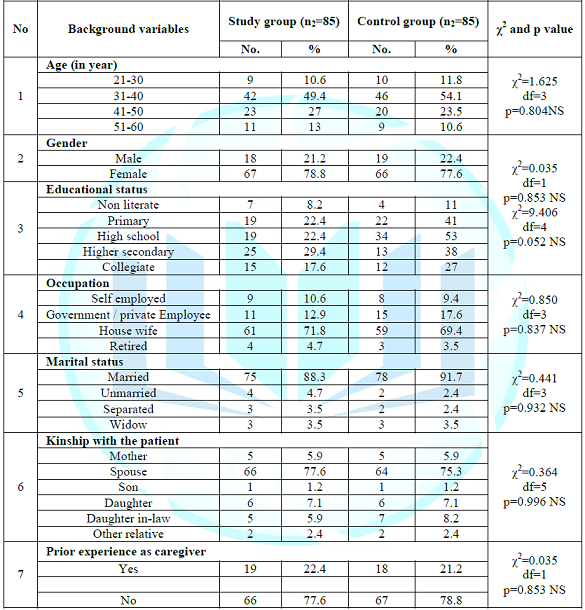Introduction
In recent years there has been an increase in economic and demographic development in developing countries resulting in a shift from disease caused by poverty toward chronic non communicable lifestyle related disease [1]. One among such disease is stroke. Stroke is also referred as Cerebrovascular Accident (CVA) or Cerebrovascular Disease (CVD) and it needs medical emergency requiring immediate treatment. Prompt treatment improves the chances of survival and increases the degree of recovery that may be expected. According to Mirzaei M et al. [2] stroke stands globally as the second most prevalent etiology of death and is rated among the top causes of morbidity in developed and developing countries. In developed country like United States, stroke prevalence seems to be high stroke; it is the third leading cause of death with a projected mortality rate of more than 140,000 people each year and with residual disabilities. Every year, approximately 795,000 people suffer from stroke where 600,000 of these are first attacks and 185,000 are recurrent. After the age of 55 the risk factor doubles for stroke prevalence. Nearly one fourth of strokes occur in people under the age of 65. Atrial Fibrillation (AF) is an independent risk factor for stroke; increasing the risk about five-fold [3].
World Health Organization (WHO) project on stroke describes that Indian terrain has a major risk pose due to stroke where the prevalence was 55.6 per 100,000 at all ages [3]. 0.63 Million deaths occur in every year. Nearly 1.44-1.64 million cases of new acute strokes bloom every year [4]. 12% of strokes occur in population aged less than 40 years [5]. 28-30 days case fatality ranges from 18-41% [6]. The economic burden caused by stroke has not been explored in India. However, India is estimated to have lost 8.7 billion 1998 international dollars in 2005 due to Coronary Heart Disease (CHD), stroke and diabetes. This is to increase to 54 billion 1998 international dollars by 2015 and Indias growth of Gross Domestic Product (GDP) is estimated to fall by 1% because of the combined economic impact of CHD, stroke, and diabetes [4]. Recovery after stroke is physically and mentally exhausting since stroke affects each person differently. Patients must be persistent enough to achieve favorable recovery following stroke. Stroke is a leading cause of functional impairments, with 20% of survivors requiring institutional care after 3 months and 15%-30% being permanently disabled [7].
Stroke is a life-changing event that affects not only the person who may be disabled, but also their family and caregivers. There is life after a stroke and there are things that can be done to reduce the disability and burden imposed on the patient and their caregiver. Complete recovery may not be possible for all the patients, but improved quality of life can be achieved often.
Objectives
· Determine the effectiveness of CSEP on knowledge among patients with stroke.
· Find out the effectiveness of CSEP on quality of life in the following aspects: ADL, generic and stroke specific quality of life among patients with stroke.
· Evaluate the effectiveness of CSEP on knowledge among caregivers of patients with stroke.
· Elicit the effectiveness of CSEP on burden among caregivers of patients with stroke.
Background of the Study
Stroke is a clinical syndrome describing a range of disorders which result in focal cerebral ischemia. WHO defines stroke as rapidly developing clinical signs of focal (or global) disturbance of cerebral function, with symptoms lasting for 24 hours or longer, or leading to death, with no apparent cause other than of vascular origin. The most vital symptoms of a stroke is sudden weakness or numbness of the face, arm, or leg, most often involving one side of the body, occurring in 90% of the patients with stroke. Other symptoms include misperception, trouble in dialogues or understanding speech, difficulty in seeing the visual fields, difficulty walking, dizziness and loss of balance or coordination, severe headache with no known cause and fainting or unconsciousness. Many people think that they would work until they retire, but sometimes it does not work out that way. There are many different types of illnesses that can affect people at different times and with a little to no warning. CVA is one of these diseases that can strike with little warning and can have a dramatic effect on ones life. Primary prevention is particularly important because >70% of strokes are first events. Secondary prevention strategies include pharmacotherapy with aspirin, dipyridamole, and clopidogrel. More recent evidence suggests that a 24% reduction of death from all vascular causes can be achieved with of use aspirin and dipyridamole; however caution is required with dipyridamole as it is not well tolerated by the patients [7]. The most common predictors of death from stroke for those aged more than 65 years of age include previous stroke and atrial fibrillation. Stroke alters day to day life of patients and their family. Caregivers face a burden in taking care of stroke patients due to sudden change in the lifestyle and isolation that often follow a stroke.
Well-organized stroke services are severely lacking in the government sector of India, and most stroke centers are situated in the private and urban settings in India, when 70% of the population lives in rural areas [8]. As such, modern acute stroke care (with optimal use of intensive care units, neuroimaging, thrombolytic evaluation, monitoring and intensive rehabilitation) appears beyond the reach of most patients [3]. An urban, hospital-based study conducted by Srivastava and Prasad [9] indicated that the median time from the onset of stroke to the arrival at hospital was 7.6 hours and that only 25% of patients were presented to hospital within 3 hours of stroke. In comparison, a similar study undertaken in a rural area identified that the mean arrival time of stroke patients to hospital was 34+/-6 hours. Living in a city with a presence of family history of stroke and older age were all positively associated with early arrival. Additionally, another study signifies that the late arrival was associated to lack of transportation with only 12% reaching the hospital by ambulance and 17% by bicycle or rickshaw [10].
More specifically related to stroke, national policies should emphasize on:
· Evidence-based training of community physicians and health workers in the prevention, diagnosis, management, and rehabilitation of stroke.
· Evidence-based public education about stroke warning symptoms, risk factors, morbidity, mortality, and importance of time window for acute treatment.
· Capacity building to provide enough resources for above education and delivery of stroke-related services.
Well, Wood et al. [11] identified that the need for better information, in addition to greater provision of support which had been voiced out by the stroke patients and their caregivers. 40% of the stroke patients and 45% of the caregivers were dissatisfied with the information received about stroke before discharge. He also stated that the information needs of patient and their caregiver in hospital and after discharge are not being met, despite the efforts of health services and voluntary agencies. This may be due to the stressful situation, or the information was not clear, was too complicated, was too general and did not address the patient or caregiver own issues of concern. Limited amount of patient knowledge and public awareness of stroke, its symptoms and risk factors exist in India. In future studies need to focus on different Indian communities, giving the vast diversity within India. Lastly, efforts are urgently needed to educate the public about stroke symptoms, diagnosis, and treatment. So as to optimize health care decisions and behaviors in order to help curb the growing stroke problem in India [10].
Cross sectional survey conducted by Cleusa Ferri et al. [12] Investigated prevalence of stroke and related burden among older people living in Latin America, India and China. Self-reported stroke diagnosis, caregiver burden was assessed using a standardized protocol. The proportion of stroke survivors who needs care varied between 20% and 39%. 87.5% of caregivers in rural India had to cut back their own jobs to take care of the stroke patients and 20% of them employed paid caregivers. Increasing age and dementia made largest contribution to caregivers strain. Self-reported survey executed by Nina Fudge et al. [13] among 1251 stroke patients to identify the long-term needs after stroke among United Kingdom population with 44 closed questions revealed 50% of them reported three unmet needs that are physical and other stroke related problems (mobility-5%, fall-21%, pain-34%, incontinence-21%, emotional problems-39%), 54% reported that they needed more information regarding stroke and 52% of them mentioned social problems that changed leisure activities, loss of income due to stroke and increase of expenses.
Larson J et al. [14] determined the impact of a nurse led support and education program for spouses of stroke patients. The study findings revealed that intervention group had significant decrease in negative wellbeing and increased quality of life over a period of time whereas the control group showed significant decrease in negative and general wellbeing. The results showed that the support and educational program might have positive effect on spouses wellbeing. Helen Rodgers et al. [15] proved that provision of structured, personalized information to the patient with stroke and their caregiver by a specialist nurse will improve knowledge, quality of life and satisfaction with the information that they received. Nurses specializing in rehabilitation train the stroke patients to relearn how to carry out the basic activities of daily living. They also educate survivors about routine health care, such as how to follow a medication schedule, how to care for the skin, how to move out of a bed and into a wheelchair, and special needs for people with diabetes and hypertension. Rehabilitation nurses also work with stroke patients to reduce risk factors and provide training for caregivers. The challenge for the future is to develop new approaches that will enhance stroke outcome. More randomized controlled trials comparing stroke educational program are thus urgently required.
Limited amount of patient knowledge and public awareness of stroke, its symptoms and risk factors exist in India. Efforts are urgently needed to educate the public about stroke symptoms, diagnosis, and treatment. To optimize health care decisions and behaviors in order to curb the growing stroke problem in India. Comprehensive Stroke Education Program which is designed for the stroke patient and their caregiver enhances the knowledge on stroke, improve functional ability, management of post stroke complications, adherence to medication, engagement in healthy behavior to prevent further stroke, reduce the health care cost and to promote quality of life. With these ideas the investigator felt a strong need to undertake the study.
Materials and Methods
Research Design
True experimental study design was used to determine the effectiveness of CSEP on knowledge and QoL among patients with stroke and knowledge and burden among caregivers by adopting randomized controlled trial (Table 1).
Table 1: Research design of the study.

Intervention
R: Randomization
O1 (Patient): Assessment of knowledge on stroke, ADL and generic quality of life as a pretest measure
O1 (Caregiver): Assessment of knowledge on stroke as a pretest measure
*: Routine care
X: Comprehensive Stroke Education Program
O2 (Patient): First posttest assessment of knowledge on stroke, ADL, generic and disease Specific quality of life on 30th day after the discharge
O2 (Caregiver): First posttest assessment of knowledge on stroke and burden among caregiver on 30th day after the discharge of the patient
O3 (Patient): Second posttest assessment of knowledge on stroke, ADL, generic and disease specific quality of life on 90th day after the discharge
O3 (Caregiver): Second posttest assessment of knowledge on stroke and burden among caregiver on 90th day after the discharge of the patient
O4 (Patient): Third posttest assessment of knowledge on stroke, ADL, generic and disease specific quality of life on 180th day after the discharge
O4 (Caregiver): Third posttest assessment of knowledge on stroke and burden among caregiver on 180th day after the discharge of the patient
√: Issue of booklet to control group dyad
Intervention
Intervention refers to the Comprehensive Stroke Education Program that was provided by the investigator to the patients with stroke and their caregivers in the study group apart from the routine care. Laptop assisted teaching by lecture method was used to teach the dyads (patient+caregiver) on one to one basis. The teaching module prepared by the investigator and validated by the experts was used to teach the study participants. It consisted of a 40-minute inpatient teaching session each day for three consecutive days for the patients with stroke and their caregivers which included,
Day 1: General information on stroke and its management
Day 2: Symptomatic management of-swallowing problems, bowel and bladder problems, memory problems, speech and vision problems, prevention of complications such as pressure sore, injury to affected limbs, fall prevention, swelling of affected limbs, post stroke depression and tips for caregivers which was tailored to the needs of the individual patients.
Day 3: Assisting with the personal activities of daily living (bathing, toileting, grooming and feeding), performance of Range of Joint Movement (ROJM) exercise.
Booklet on Life after stroke was provided for the study group participants on the day of discharge and it contained the information on components of Comprehensive Stroke Education Program. Telephone call was made once in every fortnight after the discharge from the hospital till the 180th day, for regular follow up and adherence to medication. Reinforcement was carried out as a part of CSEP to the dyads following posttest-I and II by the investigator which was tailored to the need of the individual patients.
Control
The patients and their caregivers in the control group received routine care given by the doctors, nurses and other paramedical personnel in the health care facility. Immediately after posttest III the investigator offered the same booklet on Life after stroke to the control group dyads. The data obtained from the control group were utilized to compare with the data of the study group; the effectiveness of CSEP was evaluated. The presence of control group also helped the investigator to overcome the extraneous variables.
Randomization
Patients who were diagnosed to have ischemic and hemorrhagic stroke based on CT-scan findings with modified Rankin Scale (mRS) grade 1-4, which indicates mild to moderate disability after stroke were considered as stroke. A simple random sampling by using a lottery method was adopted to assign the group. Samples were randomly assigned in the presence of the caregivers to the study group or to the control group. Equal number of lots (85 chits for the study group and 85 chits for the control group) were made and kept in a box. Patients and their caregivers who fulfilled the inclusion criteria were allowed to choose their lots from the box. Based on the lot, 85 patients and their caregivers were assigned to the study group and 85 patients and their caregivers were assigned to the control group.
Variables of the Study
Independent variable: The independent variable in this study was Comprehensive Stroke Education Program
Dependent variable: The dependent variables in this study were knowledge on stroke, ADL, generic and disease specific quality of life and level of burden.
Setting
This study was conducted at Sri Ramachandra Medical Centre (SRMC), Porur, Chennai - 600116. It is a 1675 bedded multi-specialty hospital. The pretest was conducted in neurology wards and the posttest was conducted at neurology Outpatient Department (OPD) of SRMC.
Population
The accessible population for the study was patients who had stroke and their caregiver admitted in Sri Ramachandra Medical Centre. The target population for the study was patients who were diagnosed to have ischemic and hemorrhagic stroke based on CT-scan findings with mRS grade 1- 4 score, which indicates mild to moderate disability after stroke were considered as stroke victims and their caregivers at Sri Ramachandra Medical Centre, Porur, Chennai- 116 during the period of data collection.
Sample
Patients who were diagnosed with ischemic and hemorrhagic stroke as per CT- scan findings with mRS grade 1-4 score and who fulfilled the inclusion criteria were selected. The total number of sample was 170 dyads in that 85 dyads in the study group and 85 dyads in the control group were recruited as samples by lottery method. Informed consent was obtained from the dyads from both the groups.
Sample Size and Attrition
The sample size was 170 dyads (170 patients and 170 caregivers) which was equally divided in to the study group (n1=85 patients and n2=85 caregivers) and the control group (n1=85 patients and n2=85 caregivers), Using power analysis, the sample size was estimated as 75 for each group (total=150), to achieve 80% power at a 5% level of significance, Considering the chance of attrition, an increase of 10% was done and the obtained value was rounded to 170. 170 patients and 170 caregivers were included for this study. At 90th day, during posttest-II two caregivers from study group and two caregivers from control group did not accompany the patients for the follow up visit due to their family commitment. At 180th day during posttest-III in study group two subjects got readmitted, one did not respond to calls and one did not come for follow-up due to financial burden. At 180th day during posttest-III in control group three subjects got readmitted, one did not respond to calls and one did not come for follow-up due to financial burden. Totally at the end of posttest-III 81 patients and 79 caregivers were followed up whereas in control group 80 patients and 78 caregivers were assessed (Appendix).
Sampling Criteria
For the patient-Inclusion criteria
Patients who were
· Between the age of 30 to 60 years
· Both male and female
· Modified Rankin grade of 1-4
· Conscious, alert and oriented to time, place and person
· Accompanied by caregiver
· Able to speak either Tamil and /or English
For the patient-Exclusion criteria Patients who were
· Not willing to participate
· Having problems with communication other than stuttering
· Diagnosed to have complete blindness
For the caregivers-Inclusion criteria Care givers who were
· Between the age of 20 to 65 years
· Both male and female
· Able to meet their ADL on their own
· Willing to provide care to the patient after the discharge till 180 days and above
· Able to speak Tamil and/or English
For the caregivers-Exclusion criteria
· Not willing to participate as dyad
Description of the instrument
Section I
Part A: Demographic variables of the patient: It consisted of patient age, gender, education, occupation, marital status, residence, monthly income and type of family.
Part B: Clinical variables of the patient: It consisted of risk factors of stroke, subtype of stroke and neurological deficit.
Part C: Background variables of the caregivers: It consisted of age, gender, education, occupation, marital status and relationship with the patient and prior experience as caregiver.
Section II
Part A: Stroke Knowledge Test (SKT)
It was developed by Karen Sullivan and Natalie Dunton which has 20 multiple choice each question had four choices out of which only one was the correct answer. SKT consisted of questions regarding risk factors, signs and symptoms and management of stroke. The responses were elicited by the investigator. Maximum score is 20 and minimum score is zero (r=0.83).
Part B: Barthel Index (BI)
The Barthel Index (BI) was first introduced by Mahoney and Barthel (1965). Total of 10 activities are scored, and the values are then added to give a total score ranging from 0 (totally dependent) to 100 (completely independent). Lower scores indicate greater dependency (r = 0.89).
Part C: Short form 36 V2 Questionnaire
SF 36 V2 is used to assess the generic quality of life of the patients. It was measured and standardized. The SF-36 is a multipurpose, short form health survey with only 36 questions. SF-36 V2 scores were converted to a scale of 0 to 100; a higher score indicating a better quality of life and lower score indicates poor quality of life (r=0.90).
Part D: Stroke Specific Quality of Life (SSQOL)
The Stroke Specific Quality of Life scale (SSQOL) is a patient-centered outcome measure intended to provide an assessment of health-related quality of life specific to patients with stroke. The SSQOL was published and validated in 1999 by Williams, Weinberger, Harris, and Clark. It takes approximately 10-15 minutes to complete the SSQOL scale. Higher scores indicate better functioning (r=0.8)
Part E: Burden Assessment Scale (BAS)
It is used to calculate the burden experienced by caregivers caring for a loved one. It was developed by Rhonda J.V. Montgomery and it has 22 items related to feelings regarding caring for relative, sense of responsibility, feelings due to impairment and relationship with family and friends in a five-point Likert scale. Minimum score is 0 and maximum score 88.
Data Collection Procedure
The study proposal was presented to ethical committee, SRU and was approved. Then permission was obtained from the Head of the Department, Department of Neurology, SRMC, Porur, Chennai- 600 116. The dyads that fulfilled inclusion criteria were selected by lottery method. Throughout the study period totally 345 patients were assessed for eligibility out of which only 170 dyads who fulfilled the inclusion criteria were included to the study. Informed consent was obtained from dyads after adequate explanation about the risk and benefits of the study from both the groups. Pretest assessments were taken using structured questionnaire for the patient and knowledge was assessed for the caregiver by the investigator for both the groups.
Following pretest, Comprehensive Stroke Education program was implemented to the study group dyads apart from the routine care by laptop assisted teaching by lecture and discussion methods on one to one basis. The teaching module prepared by the investigator and validated by the experts was used to teach the dyads. It consists of a 40-minute inpatient teaching session each day for three consecutive days for the patients with stroke and their caregivers. Booklet on Life after stroke was provided for the study group participants on the day of discharge and it contained the information on components of Comprehensive Stroke Education Program. Telephone calls were made once in every fortnight till the 180th day after their discharge from the hospital for regular follow up and adherence to medication. Reinforcement was carried out as a part of CSEP following posttest-I and II by the investigator on CSEP, which was tailored to the need of the individual patient. Control group dyads received routine care given by the doctors, nurses and other health care personnel in the health care facility.
The investigator identified the study participants every day at registration counter of neurology OPD. The first posttest was conducted for both the groups on the 30th day after the discharge from the hospital, to assess the knowledge on stroke, ADL and generic and disease specific QoL of patients and knowledge and burden among caregivers at Neurology OPD of SRMC. SSQOL was used to measure the Stroke Specific Quality of Life. Burden experienced by the caregivers was measured by using Burden Assessment Scale. After Posttest-I reinforcement on CSEP was rendered to the study group dyad that was tailored to the need of the individual patient. The second and third posttest was conducted for both the groups on the 90th day and 180th after the discharge from the hospital, to assess the knowledge on stroke, ADL and generic and disease specific quality of life among patients and knowledge and burden among caregivers at Neurology OPD of SRMC. Soon after the Posttest-III, the same booklet on Life after stroke was issued to control group dyads (Appendix).
Table 2 depicts that majority of the participants 32 (37.6%) were in the age between 41-50 years in the study group and 31 (36.5%) participants were in the age between 41-50 years in the control group. 65 (76.5%) participants were male in the study group and 54 (63.5%) participants were male in the control group. 68 (80%) and 71 (83.5%) participants were married in the study group and control group respectively. Most of the participants live in urban area, 31 (36.5%) in the study group and 42 (49.4%) in the control group. Regarding educational status 23 (27.1%) of them in the study group and 21 (24.7%) of them in the control group had collegiate level of education.
Table 3 shows the frequency and percentage distribution of stroke risk factors, 73 (85.9%) participants in the study group and 58 (68.2%) participants in the control group suffered from hypertension. 39 (45.9%) and 48 (56.5%) participants had history of diabetes in the study and control group respectively. 27 (31.8%) in the study group and 23 (27.1%) in the control group participants were ex-smokers. 52 (61.2%) and 34 (40%) of the participants had family history of stroke in the study and control group respectively.
Table 4 illustrates that 59 (69.4%) participants had ischemic stroke and 26 (30.6%) participants had hemorrhagic stroke in study group whereas 61 (71.8%) participants suffered from ischemic stroke and 24 (28.2%) participants suffered from hemorrhagic stroke in the control group. Regarding neurological dysfunction, majority of the participants had weakness on one side of their body in both the groups.
Table 5 shows that 67 (78.8%) caregivers in the study group and 66 (77.6%) caregivers in the control group were female. Data related to occupation showed that, 61 (71.8%) caregivers in the study group and 59 (69.4%) caregivers in control group were housewives. Regarding kinship with the patient, 66 (77.6%) caregivers in the study group and 64 (75.3%) caregivers in the control group were spouse. Related to prior experience as caregiver, only 19 (22.4%) in the study group and 18 (21.2%) in the control group had prior experience.
Table 6 shows the comparison of knowledge on stroke between the groups over a period of time from pretest to posttest-III. The mean scores of knowledge showed improvement in each test than the previous test in both the groups but increase in mean score between the groups showed an improvement in knowledge on stroke in the study group than the control group which was statically significant at p<0.001.
Table 7 explains the comparison of ADL between the groups over a period of time from the pretest to posttest-III. The mean scores of overall ADL showed improvement in each test than the previous test in both the groups but the difference was high in the study group than the control group which was not statistically significant. As per the Barthel Index score interpretation if there is improvement in one mean score, it indicates that there is good improvement in the functional ability of an individual.
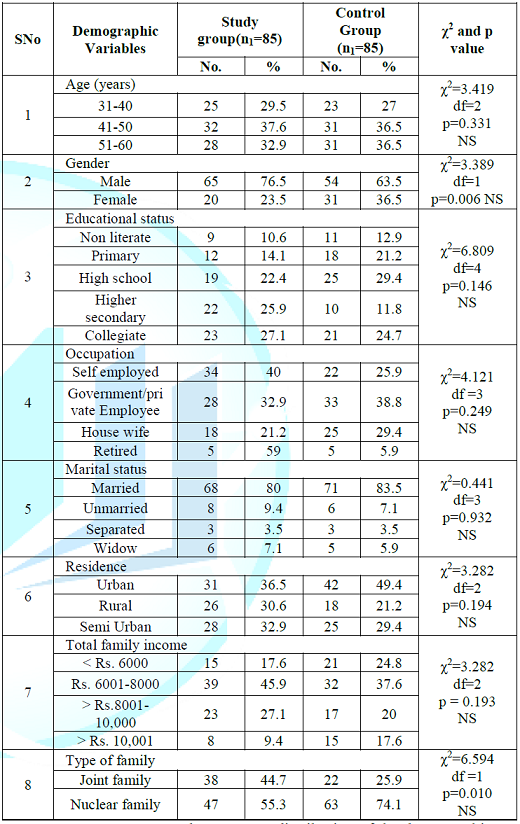
Table 8 presents the measurement of overall PCS score over a period of time from the pretest to posttest-III between the study and control group participants. There was an improvement in the mean scores in both the groups which was statistically significant at p<0.05.
Table 9 explicates the measurement of overall mental component summary score over a period of time from the pretest to posttest-III between the study and control group patients. There was an improvement in the mean scores in the study group than the control group that was statistically significant at p<0.001.
Table 10 shows the comparison of overall mean sore of SSQOL between the groups during posttest-I, II and III. The posttest-I mean score in the study and control groups were 163.53 and 163.61 respectively. The posttests mean scores in the study group were higher than that of the control group. The calculated t-values during posttest-II and III showed the presence of statistically significant difference at p<0.01 and at p<0.05 in posttest-I between the groups.
Table 11 explicated the comparison of knowledge on stroke between the groups over a period of time from pretest to posttest-III. The mean scores of knowledge showed improvement in each test than the previous test in both the group caregivers but increase in mean score was observed in the study group caregivers than in the control group caregivers which was statistically significant at p<0.001.
Table 12 explicates the comparison of burden between the groups over a period of time from posttest-I to posttest-III. The mean scores of burden showed improvement in each test than the previous test in both the group caregivers but a high mean score was observed in control group caregivers than the study group caregivers which was statistically significant at p<0.001. This indicates that control group caregivers experience more burden than study group care givers.
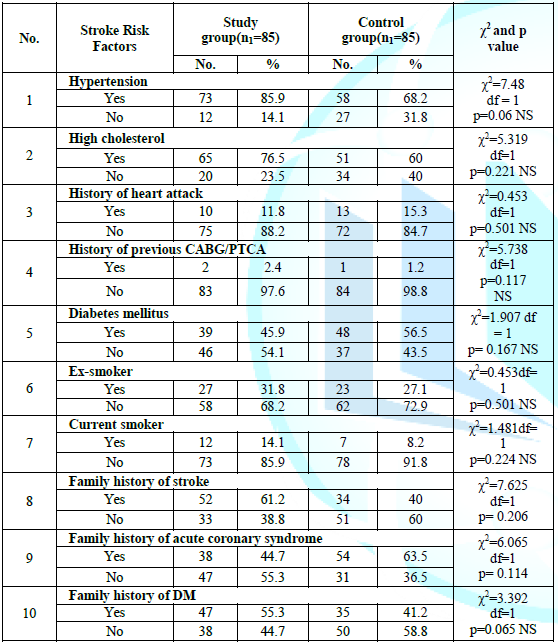
Discussion
Improvement in knowledge on stroke among Study group participants with pretest mean score of 6.61 and 13.21, 13.05, 12.75 during posttest I, II and III was statistically significant at p<0.001 level. The study findings are consistent with the results of Green T et al. [16] who examined the application of motivational interviewing and stages of change on stroke knowledge acquisition and changing individual lifestyle risk factors in an outpatient clinic through the RCT in which 200 participants were allocated to an Education-Counseling Interview (ECI) or a control group. There was a statistically significant difference between the groups from baseline (T1) to three months (T3) in stroke knowledge (p<0.001). The independent t test results revealed that the mean scores of ADL in the study group (79.06, 81.29 and 81.76) and in the control group (79.06, 81.35 and 81.63) during posttest-I, II and III was statistically significant at p<0.05 level. The comparison of mean score ADL within study group during Pretest, posttest-I, II, and III showed that the Posttest-III (81.76) mean score of ADL was higher than the score of pretest (76.24) and calculated t values were statistically significant at p<0.001. Findings revealed that after participating in CSEP, majority 70 (86.5%) of them in the study group were in the category of independent to meet their ADL during posttest-III whereas in control group only 34 (42.5%) were independent to meet their ADL in posttest-III.
Overall PCS score over a period of time from the pretest to posttest-III between the study and control group patients showed an improvement in the mean scores in both the groups which was statistically significant at p<0.05 (F=38.866). The measurement of mental component summary mean score was higher in posttest-I, II and III (38.85, 38.63 and45.93) than in pretest (34.41) and the mean difference were statistically significant at p<0.001 level. Statistically significant differences were found over a period of the study (pretest, posttest-I, II and III) with overall MCS score at p<0.001 (F= 59.527) between the study and control group patients. Comparison of overall mean score of SSQOL within the study group revealed an improvement in posttest-III (181.40) than posttest-I which was statistically significant at p<0.001. Comparison of 12 domains mean score of SSQOL within the study group patients during posttest-I and III of energy, language, mobility, self-care showed a significance statistically at p<0.001, family role, social role and thinking at p<0.01 and mood and work at p<0.05 level.
Comparison of 12 domains mean scores of SSQOL during posttest-I, II and III of energy, mobility, mood, social role and work/productivity showed a high score in the posttest-III (9.07, 25.78, 13.78, 13.61 and 11.05) than in the posttest-I (8.26, 8.72, 23.31, 12.88 and 10.76) and these differences were statistically significant at p<0.001 in the study group than the control group. Personality, upper extremity functions and vision were statistically significant at p<0.01 and language at p<0.05 among the study group patients. These findings were not detailed by the previous investigators (Figure 1).
Figure 1: Comparison of knowledge on stoke among patients between the study and control group.
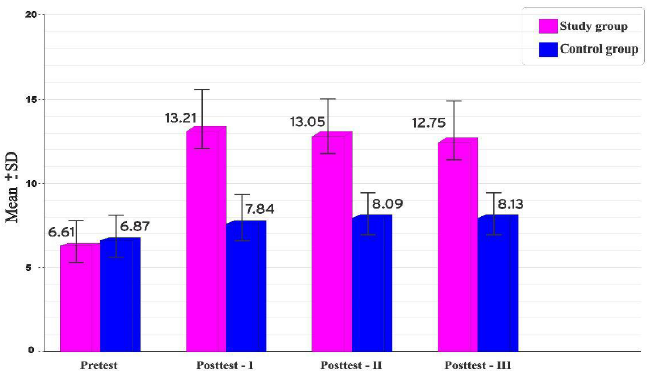
A similar study by Hopman W and Verned J [17] conducted a prospective study on quality of life during and after inpatient stroke rehabilitation program. 85 patients were followed during and after discharge from the hospital. Over a period of three years and the HRQOL was assessed by means of SF-36 and the HRQOL were assessed 6 months after discharge and the result revealed an improvement in all the eight domain with five attaining statistical significance that is role emotion, mental health, social functioning, bodily pain, and general health perception. They suggested for longitudinal study to ensure that adequate community services and support are available (Figure 2).



Table
9: Repeated measures on values of mental component
summary score at different periods of time between the study and control group
patients. Table
10: Comparison of overall SSQOL score between the study
and control group patients.
Table
10: Comparison of overall SSQOL score between the study
and control group patients.



Figure 2: Comparison of ADL among patients between the study and control group.
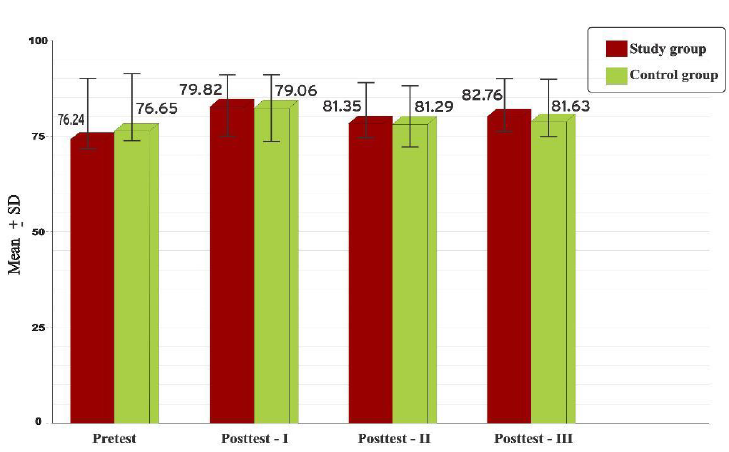
The mean score of knowledge on stroke within the study group caregivers during the pretest was 6.35 and there was a significant increase in mean score of knowledge on stroke during posttest-I, II and III (11.46. 11.68 and 11.52) which was statistically significant at p<0.001 level. The above findings supported by Choi, Seo and Kwon [18] to assess the effects of education on knowledge and practice of caregivers of the stroke patient in Gyeongsang National University Hospital, China using a non-equivalent control group non-synchronized design. Forty caregivers, twenty in the experimental group and twenty in the control group were assigned. The experimental group participated 2 times in an education class given by the researcher. Knowledge (t=5.87, p=0.00) and practice (t=5.53, p=0.00) of the experimental group were significantly different from the control group. The stroke patient care education developed in this study showed a significant promotion of knowledge and practice of caregivers.
The comparison of burden between the study and control group caregivers revealed that mean burden scores were 29.94 and 35.21during posttest-I, 31.12 and 36.86 during posttest-II, 32.69 and 36.96 during posttest III in the study and control group respectively. The mean scores were higher in the control group caregiver than the study group caregiver during the posttests and were statistically significant at p<0.01 level during posttest I and II and p<0.05 level during posttest-III. Nir, Greenberger and Bachner [19] aimed to examine the changes in caregivers burden, physical and emotional health, social support network, and Quality of Life (QOL) during the first 6 months after the stroke occurrence among primary caregivers of stroke survivors. Primary caregivers (N=140) were assessed at three intervals during this period: within 2 weeks after the stroke occurrence, in the geriatric rehabilitation ward, and at 3 and 6 months post stroke in the community. Results of the study revealed that during the 6-month period, caregivers physical health remained stable. After 3 months, depression levels decreased, as did the need for instrumental support in and outside the home. Burden decreased consistently at 3- and 6-month intervals. After 6 months, perception of health and QOL improved, whereas the other variables remained stable. These results indicate that overall that population of caregivers adapted to their role over the 6-month period. The results of the study contribute to nurses ability to identify caregivers at risk and develop appropriately timed interventions for empowering caregivers in their role fulfillment.
Conclusion
The study conclusions are, structured teaching on stroke education program enhanced the knowledge on stroke and its management, improves functional ability of patients with stroke, improved generic and disease specific quality of life of patients with stroke. Caregivers burden has significantly reduced with CSEP. This study suggests that the inpatient stroke education program involving family caregiver will enhance both individual and caregiver wellbeing and promotes quality of life.
Recommendations
· A comparative study could be conducted between inpatient and outpatient teaching program.
· Similar study could be conducted as community outreach program.
· Long-term follow-up study after comprehensive stroke education program among patients with stroke could be conducted to assess the obtained benefits.
· A similar study could be conducted with other teaching aids e.g. video assisted teaching.
· A multicenter study could be carried out with the same interventions.
· Phenomenology study could be conducted to find out the needs of caregivers of stroke survivors.
· A comparative study could be conducted to assess the level of burden between both the genders.
· A correlation study could be conducted to find out the relationship among the study variables.
Implications
Nursing practice
· Public education and control of risk factors at a primary care level is the most appropriate strategy to meet the growing challenge of stroke.
· Nurses have close contact with patient so they must take this opportunity to involve family members to enhance their knowledge on stroke rehabilitation to improve the quality of life of their loved one.
· Nurses can also plan an inpatient stroke rehabilitation program, which will pave the way for cost effective and better outcome of both individual and family.
· Nurses must be able to identify and meet the needs of caregiver of patients with stroke, which will promote both patient and care giver wellbeing.
· Expanded role of nurse by reinforcement of patient to have control over risk factor of stroke thereby, improving the quality of life after stroke.
Nursing education
· In the curriculum there must be inclusion of skill in identifying the family caregiver and how to assess the needs of the family for long-term diseases.
· Various modes of stroke rehabilitation programs should be added into the curriculum.
· The curriculum should augment the self-management skills to aid patients to adapt such skills to facilitate their quality of life (Figure 3).
Figure: 3 comparison of overall SSQOL among patients between the study and control group.
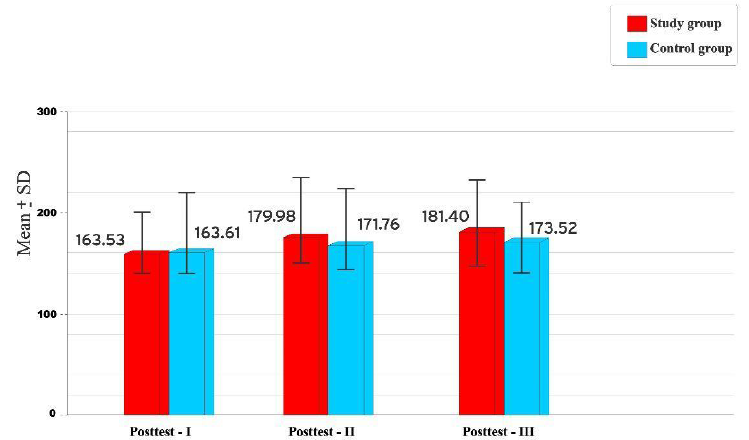
Nursing administration
· Organizing support and educational program, empowerment, approach and implementing coping strategies will enhance the functional ability and quality of life of patient with stroke.
· Take initiatives to organize the stroke units to promote stroke services (Figure 4).
· Arrange community outreach program to meet the patients and caregivers at home in order to minimize the burden of the disease (Figure 5).
Figure 4: comparison of knowledge on stroke among care givers between the study and control group.
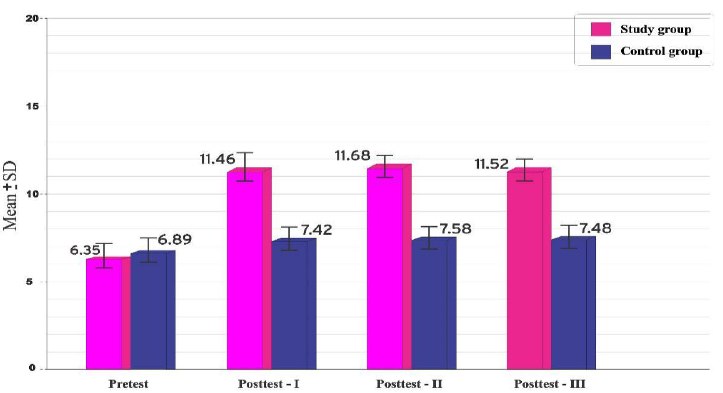
Figure 5: comparison of burden among care givers between the study and control group.
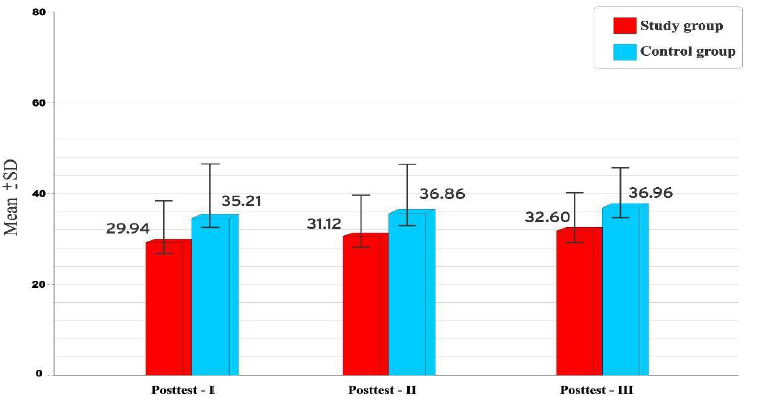
Nursing research
· Nurse must maintain the registry of morbidity, mortality, institutionalism and disability for the future study purpose.
· A longitudinal research would be more beneficial to assess the long-term benefits of stroke rehabilitation.
· Explorative study could be conducted to find the need of the caregivers of patients with stroke.
References
2. Mirzaei M, Truswell AS, Arnett K, Page A, Taylor R, et al. Cerebrovascular disease in 48 countries: secular trend in mortality (2012) J Neurol Neurosurg Psychiatry 83: 138-145. https://doi.org/10.1136/jnnp-2011-300408
3. Dalal P, Bhattacharjee M, Vairale J and Bhat P. UN millennium development goals: can we halt the stroke epidemic in India? (2007) J Indian Acade Neuro 10: 130-36. https://doi.org/10.4103/0972-2327.34791
4. Preventing chronic diseases: A vital investment (2005) Geneva, Switzerland.
5. Shah B and Mathur P. Workshop report on stroke surveillance in India (2006) Indian Council of Medical Research, India.
6. Dalal P, Malik S, Bhattacharjee M, Trivedi N D, Vairale J, et al. Population-bases stroke survey in Mumbai, India: incidence and 28-day case fatality (2008) Neuroepidemiology 31: 254-261. https://doi.org/10.1159/000165364
7. Adams J R, Albers G, Alberts JM, Benavente O, Furie K, et al. Update of the AHA/ASA recommendations for the prevention of stroke in patients with stroke and transient ischemic attacks (2008) Stroke 39: 1647-1652. https://doi.org/10.1161/strokeaha.107.189063
8. Murthy J. Thrombolysis for stroke in India: Miles to go (2007) Neuro India 55: 3-5. https://doi.org/10.4103/0028-3886.30415
9. Srivatsava A and Prasad K. A study of factors delaying hospital arrival of patients with acute stroke (2001) Neuro India 49: 272-276.
10. Pandian J, Srikanth V, Read SJ and Thrift AG. Poverty and stroke in India: a time to act (2007) Stroke 38: 3063-3069. https://doi.org/10.1161/STROKEAHA.107.496869
11. Well Wood I, Dennis MS and Warlow CP. Perceptions and knowledge of stroke among surviving patient s with stroke and their carers (1994) Age Ageing 23: 293-298. https://doi.org/10.1093/ageing/23.4.293
12. Cleusa P F, Schoenborn C, Kalra L, Acosta D, Guerra M, et al. Prevalence of stroke and related burden among older people living in Latin America, India and China (2011) J Neuro Neurosurg Psy 82: 1074-1082. http://dx.doi.org/10.1136/jnnp.2010.234153
13. McKevitt C, Fudge N, Redfern J, Sheldenkar A, Crichton S, et al. Self-reported long-term needs after stroke (2010) Stroke 42: 1398-1403. https://doi.org/10.1161/STROKEAHA.110.598839
14. Larson J, Franzen-Dahlin A, Billing E, Arbin M, Murray V, et al. The Impact of a nurse led support and education program for spouses of stroke patients: a randomized controlled trial (2005) J clinical nursing 14: 995-1003. https://doi.org/10.1111/j.1365-2702.2005.01206.x
15. Rodgers H, Atkinson C, Bond S, Suddes M, Dobson R, et al. Randomized controlled trial-a comprehensive stroke education program from patients and caregivers (1999) Stroke 30: 2585-2591. https://doi.org/10.1161/01.str.30.12.2585
16. Green T, Haley E, Eliasziw M and Hoyte K. Education in stroke prevention: Efficacy of an educational counseling intervention to increase knowledge in stroke survivors (2007) J Neuroscience Nursing 29: 13-20.
17.
Stroke, knowledge, Quality of Life, Burden, Caregivers.Keywords


 PDF
PDF